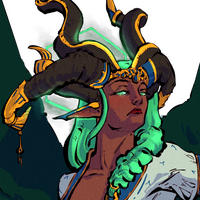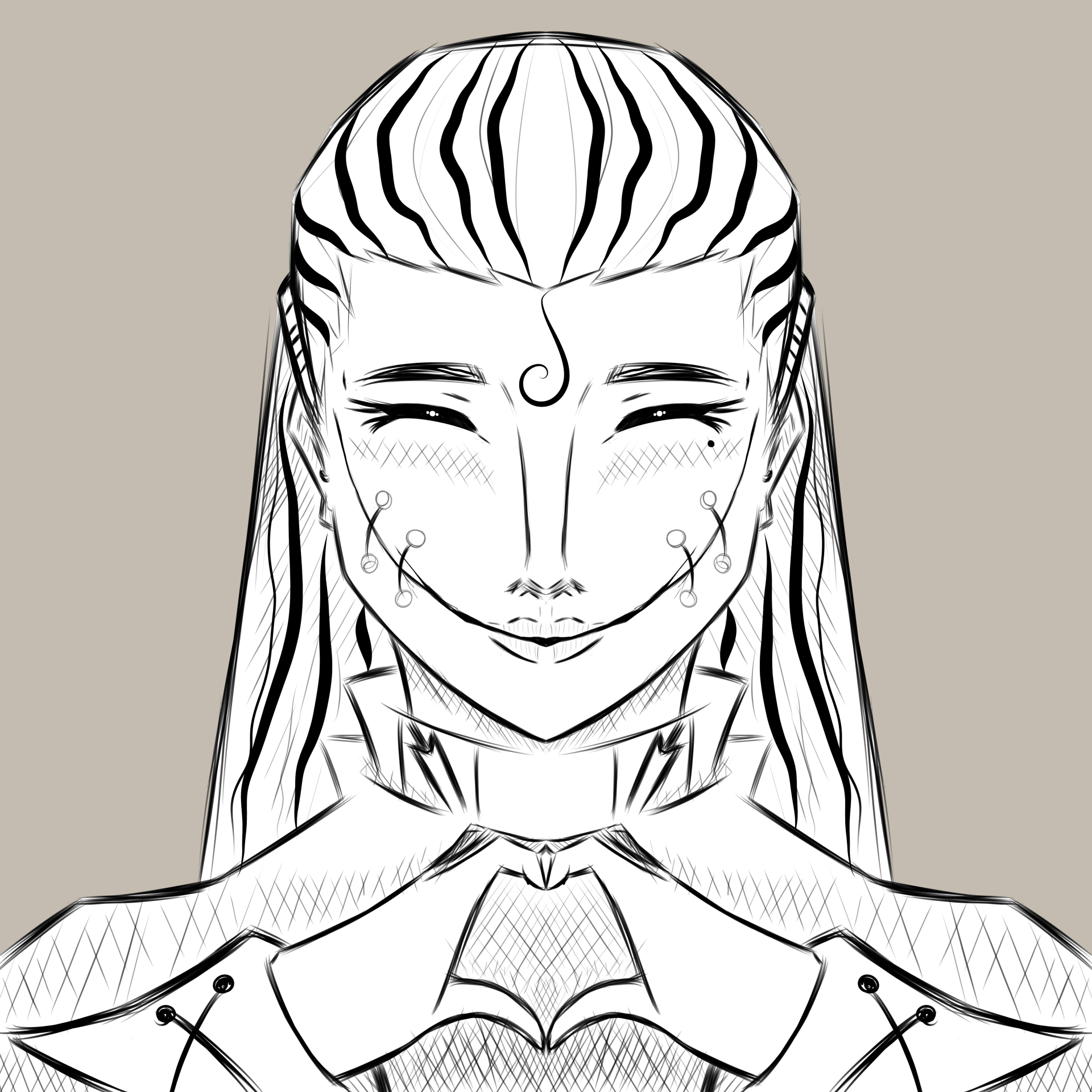Apor
Appearance
Apor was a tall woman with radiant platinum-gold skin. Her long brown hair flowed towards the ground. The goddess’s thick eyebrows, scarlet eyes and strong facial features gave her a stern and noble look.Apor possessed six arms, able to move each independently with ease. Jewellery chains adorned her body, ringing softly upon each movement.
Children
Together with other gods, Apor protected Shemokmedi for centuries. She learned of Med'Hea descending on the 13th planet, Ayonerra. The Green Witch had massacred the planet’s native race, Hskaner, and waged war on the Sun.Apor didn’t want Med’Hea to hoard precious hska metal. She stepped onto the barren planet and gave birth to three sons - Nimrod, Qasim and Sharaakh. With the children’s help, the Fourth God gathered dead hska armour. She mixed the metal with soil, moulded it into body parts, and laid the pieces down. The fragments found each other, and thus, the first Dharaats were born.
Thanks to dharaats, Apor learned to care for others and found comfort in her people’s presence. The Fourth God led her creations and helped them build grand civilisations across Teokali. She was their supreme goddess, their mighty queen, and their devoted mother. As centuries passed, her love for Ayonerra blossomed, and seeds of doubt emerged. She knew the Sun would destroy Ayonerra if Med’Hea’s control faltered. And so, if the planet ever suffered Shemokmedi’s wrath, the Fourth God vowed to protect her people and the new home to her last breath.
The Rain
When the Rain of Amaars struck, Apor was ready to fulfil her promise. Knowing the Sun would punish her disobedience, the three sons pleaded with their mother to reconsider and swore they’d protect Ayonerra in her stead. But as the creatures wreaked havoc, Apor gathered Amaars, lay down to amass all her strength and was ready to turn herself into a powerful eruption.Qasim grasped her arm, begging for her to reconsider.
Weeping, Sharaakh fell to the ground, clutching Apor's feet, unable to utter a single word.
But the goddess’s heart didn’t waver. Every nearby Amaar met its demise, while her sons’ golden flesh sustained not a single scratch. As Nimrod glanced downwards, he saw the mother’s severed head rest in his arms. Qasim held Apor’s arm, while Sharaakh clutched the goddess’s legs.
Cradling Apor’s head, Nimrod ascended the neighbouring mountains and turned himself into an impenetrable fortress. The devoted son forbade Sharaakh and Qasim from meeting their mother and swore to always keep Apor safe.
The Holy Pieces
Apor’s martyrdom ensured Ayonerra’s survival. Qasim took her one arm and protected it inside the Bridge Empire's shrine. Dharaats, meanwhile, spread her other five arms throughout Ayonerra and built grand temples to keep them safe. Each piece is still alive, moving subtly and showing no signs of decay. Upon praying and touching the goddess’s arm, a dharaat receives a specific blessing.a Firozi Temple - Infusing medical substances with magic, heightening their effect.
a Lazhvurdian Temple – Enhancing their own or other dharaat bodies.
a Nikophsian Temple – Exchanging energy with soil and buried hska armour, using them as additional sustenance.
a Northern Divider Temple - Visualizing strengths and weaknesses within the human body.
a Bridge Empire’s Temple – Enhanced reaction time.
a Amaarioni Temple – Vibration sensing, allowing a dharaat to orient themselves in complete darkness and sense approaching people.
Upon visiting all six temples, the dharaat hears Apor’s call and travels to the Nimrodial Library. The goddess meets the pilgrim and grants them an individual blessing. The Fourth God offers those she deems worthy to stay by her side as guardians and gain the library’s vast knowledge.
Yet, two of the martyr's limbs remain hidden from prying eyes. Sharaakh carries the mother’s legs behind his back. The left leg allows him to absorb non-living material he touches and gain its properties. He can also hide his body parts by pulling them inside his flesh.
The right leg lets Sharaakh rearrange his internal organs. He can also take the organs or absorbed materials out of his body. If he completely removes the material, he can't use its properties anymore.
The Beloved Martyr
Apor’s selfless sacrifice touched people’s hearts. She is widely seen as a protector of not only dharaats but all Ayonerrans. Countless stories, theatre plays and art depict the goddess, cementing her as one of the most respected deities of the twelve ascended gods. Dharaat parents often begin fairy tales by saying, “long ago, when Apor was whole…”.The exact date of the goddess’s martyrdom is contested. Most cultures choose the last day of the Month of Apor to mourn her loss.
In the Asyeendi tribe, the elder sculpts Apor’s effigy with clay. As the night draws near, the tribe gathers around a bonfire. With tearful eyes, the elder breaks apart the effigy and throws its torso into the flames. They command the goddess’s bravery and pray for her protection. Others join in, wishing Apor to be whole once more. The elder strings the effigy’s head and limbs into a necklace and wears the amulet all year.
In the Leziyi tribe, the chief leads the final night of Apor. After a day of fasting and prayer, the chief strikes his stomach and heart. Till the last breath, he pleads the goddess to accept his sacrifice and bless his tribe. The Leziyi forge chains from his torso, and bind his limbs and head to the next chief, who must carry the pieces until his martyrdom comes.
Hundreds of other localised customs have developed over the centuries to pay respect to the Fourth God.
Notable Relationships
Shemokmedi
Initially, Apor felt indebted to the Sun. She fiercely protected it from Sheutsnobeli and later Med’Hea. But her loyalty dwindled after becoming fond of dharaats and Ayonerra.She doesn’t regret opposing Shemokmedi and would have done it again without hesitation
The three sons
Apor split her love evenly between her sons. She often spoke of how the three brothers were a single whole and fortunate to always have each other. However, this view caused Apor to overlook their individual needs. The goddess noticed the sons bickering for her attention and deemed it a sweet, childish squabble. Yet, Apor was blind to the demigods' festering resentment towards each other.Apor hasn't realised Nimrod is holding her head. Nor does she know where Qasim and Sharaakh are. She wonders about their fates and if the three are still together. The Fourth God always asks visiting dharaats about her children's whereabouts. Yet, no one dares to speak the truth and break the goddess's heart.












Apor has to be my favourite god of yours ^^ Her story is so sad yet touching, and her love for her people and sons is admirable. Also, I've already said this, but her art is so lovely!!! Especially the relief of her martyrdom. Just *chef's kiss*
Thank you!